Numerical Simulation on Spatial-Frequency Domain Imaging for Estimating Optical Absorption and Scattering Properties of Two-Layered Horticultural Products
Abstract
1. Introduction
2. Materials and Methods
2.1. Principle and Diffusion Model
2.2. Monte Carlo Simulations
2.3. Inverse Algorithm for Estimating Optical Properties of Two-Layered Samples
3. Results
3.1. Effect of Varying Optical Properties on Diffuse Reflectance
3.2. Optical Property Extraction from MC-Generated Reflectance
3.3. Factors Influencing Optical Property Extraction of Top Layer
3.4. Relationship Between Light Penetration Depth and Spatial Frequency
4. Discussion
5. Conclusions
Supplementary Materials
Author Contributions
Funding
Acknowledgments
Conflicts of Interest
References
- Huang, Y.; Lu, R.; Hu, D.; Chen, K. Quality assessment of tomato fruit by optical absorption and scattering properties. Postharvest Biol. Technol. 2018, 143, 78–85. [Google Scholar] [CrossRef]
- Sun, C.; Van Beers, R.; Aernouts, B.; Saeys, W. Bulk optical properties of citrus tissues and the relationship with quality properties. Postharvest Biol. Technol. 2020, 163, 111127. [Google Scholar] [CrossRef]
- Vanoli, M.; Van Beers, R.; Sadar, N.; Rizzolo, A.; Buccheri, M.; Grassi, M.; Lovati, F.; Nicolaï, B.; Aernouts, B.; Watté, R. Time-and spatially-resolved spectroscopy to determine the bulk optical properties of ‘Braeburn’apples after ripening in shelf life. Postharvest Biol. Technol. 2020, 168, 111233. [Google Scholar] [CrossRef]
- Kienle, A.; Patterson, M.S.; Dögnitz, N.; Bays, R.; Wagnières, G.; Van Den Bergh, H. Noninvasive determination of the optical properties of two-layered turbid media. Appl. Opt. 1998, 37, 779–791. [Google Scholar] [CrossRef] [PubMed]
- Cen, H.; Lu, R. Quantification of the optical properties of two-layer turbid materials using a hyperspectral imaging-based spatially-resolved technique. Appl. Opt. 2009, 48, 5612–5623. [Google Scholar] [CrossRef]
- Liemert, A.; Kienle, A. Analytical approach for solving the radiative transfer equation in two-dimensional layered media. J. Quant. Spectrosc. Radiat. Transf. 2012, 113, 559–564. [Google Scholar] [CrossRef]
- Wang, A.; Wei, X. A sequential method for estimating the optical properties of two-layer agro-products from spatially-resolved diffuse reflectance: Simulation. Artif. Intell. Agric. 2019, 3, 69–78. [Google Scholar] [CrossRef]
- Weber, J.R.; Cuccia, D.J.; Durkin, A.J.; Tromberg, B.J. Noncontact imaging of absorption and scattering in layered tissue using spatially modulated structured light. J. Appl. Phys. 2009, 105, 102028. [Google Scholar] [CrossRef]
- Tabassum, S.; Pera, V.; Greening, G.; Muldoon, T.J.; Roblyer, D. Two-layer inverse model for improved longitudinal preclinical tumor imaging in the spatial frequency domain. J. Biomed. Opt. 2018, 23, 076011. [Google Scholar] [CrossRef]
- Yudovsky, D.; Durkin, A.J. Spatial frequency domain spectroscopy of two layer media. J. Biomed. Opt. 2011, 16, 107005. [Google Scholar] [CrossRef]
- Yudovsky, D.; Nguyen, J.Q.M.; Durkin, A.J. In Vivo spatial frequency domain spectroscopy of two layer media. J. Biomed. Opt. 2012, 17, 107006. [Google Scholar] [CrossRef] [PubMed]
- Hu, D.; Lu, R.; Ying, Y. Spatial-frequency domain imaging coupled with frequency optimization for estimating optical properties of two-layered food and agricultural products. J. Food Eng. 2020, 277, 109909. [Google Scholar] [CrossRef]
- Hu, D.; Lu, R.; Ying, Y.; Fu, X. A stepwise method for estimating optical properties of two-layer turbid media from spatial-frequency domain reflectance. Opt. Express 2019, 27, 1124–1141. [Google Scholar] [CrossRef]
- Lu, Y.; Li, R.; Lu, R. Structured-illumination reflectance imaging (SIRI) for enhanced detection of fresh bruises in apples. Postharvest Biol. Technol. 2016, 117, 89–93. [Google Scholar] [CrossRef]
- Hu, D.; Fu, X.; He, X.; Ying, Y. Noncontact and wide-field characterization of the absorption and scattering properties of apple fruit using spatial-frequency domain imaging. Sci. Rep. 2016, 6, 37920. [Google Scholar] [CrossRef] [PubMed]
- Cuccia, D.J.; Bevilacqua, F.; Durkin, A.J.; Ayers, F.R.; Tromberg, B.J. Quantitation and mapping of tissue optical properties using modulated imaging. J. Biomed. Opt. 2009, 14, 024012. [Google Scholar] [CrossRef] [PubMed]
- Svaasand, L.O.; Spott, T.; Fishkin, J.B.; Pham, T.; Tromberg, B.J.; Berns, M.W. Reflectance measurements of layered media with diffuse photon-density waves. Phys. Med. Biol. 1999, 44, 801–813. [Google Scholar] [CrossRef]
- Hu, D.; Sun, T.; Yao, L.; Yang, Z.; Wang, A.; Ying, Y. Monte Carlo: A flexible and accurate technique for modeling light transport in food and agricultural products. Trends Food Sci. Technol. 2020, 102, 280–290. [Google Scholar] [CrossRef]
- Wang, L.; Jacques, S.L.; Zheng, L. MCML-Monte carlo modeling of photon transport in multi-layered tissues. Comput. Methods Programs Biomed. 1995, 47, 131–146. [Google Scholar] [CrossRef]
- Lu, R.; Van Beers, R.; Saeys, W.; Li, C.; Cen, H. Measurement of optical properties of fruits and vegetables: A review. Postharvest Biol. Technol. 2020, 159, 111003. [Google Scholar] [CrossRef]
- Xie, D.; Guo, W. Measurement and Calculation Methods on Absorption and Scattering Properties of Turbid Food in Vis/NIR Range. Food Bioprocess Technol. 2020, 13, 229–244. [Google Scholar] [CrossRef]
- Henyey, L.G.; Greenstein, J.L. Diffuse radiation in the galaxy. Astrophys. J. 1941, 93, 70–83. [Google Scholar] [CrossRef]
- Saeys, W.; Velazco-Roa, M.A.; Thennadil, S.N.; Ramon, H.; Nicolai, B.M. Optical propertie of apple skin and flesh in the wavelength range from 350 to 2200 nm. Appl. Opt. 2008, 47, 908–919. [Google Scholar] [CrossRef] [PubMed]
- Zhang, M.; Li, C.; Yang, F. Optical properties of blueberry flesh and skin and Monte Carlo multi-layered simulation of light interaction with fruit tissues. Postharvest Biol. Technol. 2019, 150, 28–41. [Google Scholar] [CrossRef]
- Sun, C.; Aernouts, B.; Van Beers, R.; Saeys, W. Simulation of light propagation in citrus fruit using monte carlo multi-layered (MCML) method. J. Food Eng. 2021, 291, 110225. [Google Scholar] [CrossRef]
- Aster, R.C.; Borchers, B.; Thurber, C.H. Parameter Estimation and Inverse Problems; Academic Press: Cambridge, MA, USA, 2011; Volume 90. [Google Scholar]
- Hu, D.; Lu, R.; Ying, Y. Finite element simulation of light transfer in turbid media under structured illumination. Appl. Opt. 2017, 56, 6035–6042. [Google Scholar] [CrossRef]
- Gigan, S. Optical microscopy aims deep. Nat. Photonics 2017, 11, 14–16. [Google Scholar] [CrossRef]
- Fraser, D.G.; Jordan, R.B.; Kunnemeyer, R.; McGlone, V.A. Light distribution inside mandarin fruit during internal quality assessment by NIR spectroscopy. Postharvest Biol. Technol. 2003, 27, 185–196. [Google Scholar] [CrossRef]
- Qin, J.; Lu, R. Monte Carlo simulation for quantification of light transport features in apples. Comput. Electron. Agric. 2009, 68, 44–51. [Google Scholar] [CrossRef]
- Wang, W.; Li, C. Measurement of the light absorption and scattering properties of onion skin and flesh at 633 nm. Postharvest Biol. Technol. 2013, 86, 494–501. [Google Scholar] [CrossRef]
- Chugunov, S.; Li, C. Monte Carlo simulation of light propagation in healthy and diseased onion bulbs with multiple layers. Comput. Electron. Agric. 2015, 117, 91–101. [Google Scholar] [CrossRef]
- Askoura, M.L.; Vaudelle, F.; L’Huillier, J.-P. Numerical study of light transport in apple models based on Monte Carlo simulations. Photonics 2016, 3, 2. [Google Scholar] [CrossRef]
- Tromberg, B.J.; Svaasand, L.O.; Tsay, T.-T.; Haskell, R.C. Properties of photon density waves in multiple-scattering media. Appl. Opt. 1993, 32, 607–616. [Google Scholar] [CrossRef] [PubMed]
- Cuccia, D.J.; Bevilacqua, F.; Durkin, A.J.; Tromberg, B.J. Modulated imaging quantitative analysis and tomography of turbid media in the spatial-frequency domain. Opt. Lett. 2005, 30, 1354–1356. [Google Scholar] [CrossRef]
- Lu, Y.; Li, R.; Lu, R. Gram-Schmidt orthonormalization for retrieval of amplitude images under sinusoidal patterns of illumination. Appl. Opt. 2016, 55, 6866–6873. [Google Scholar] [CrossRef]
- Meglinsky, I.; Matcher, S. Modelling the sampling volume for skin blood oxygenation measurements. Med. Biol. Eng. Comput. 2001, 39, 44–50. [Google Scholar] [CrossRef]
- Hayakawa, C.K.; Karrobi, K.; Pera, V.E.; Roblyer, D.M.; Venugopalan, V. Optical sampling depth in the spatial frequency domain. J. Biomed. Opt. 2018, 24, 071603. [Google Scholar] [CrossRef]
- Bodenschatz, N.; Krauter, P.; Liemert, A.; Kienle, A. Quantifying phase function influence in subdiffusively backscattered light. J. Biomed. Opt. 2016, 21, 035002. [Google Scholar] [CrossRef][Green Version]
- Panigrahi, S.; Gioux, S. Machine learning approach for rapid and accurate estimation of optical properties using spatial frequency domain imaging. J. Biomed. Opt. 2018, 24, 071606. [Google Scholar] [CrossRef]
- Zhao, Y.; Deng, Y.; Bao, F.; Peterson, H.; Istfan, R.; Roblyer, D. Deep learning model for ultrafast multifrequency optical property extractions for spatial frequency domain imaging. Opt. Lett. 2018, 43, 5669–5672. [Google Scholar] [CrossRef]
- Chen, M.T.; Mahmood, F.; Sweer, J.A.; Durr, N.J. GANPOP: Generative Adversarial Network Prediction of Optical Properties from Single Snapshot Wide-field Images. IEEE Trans. Med. Imaging 2019, 39, 1988–1999. [Google Scholar] [CrossRef] [PubMed]
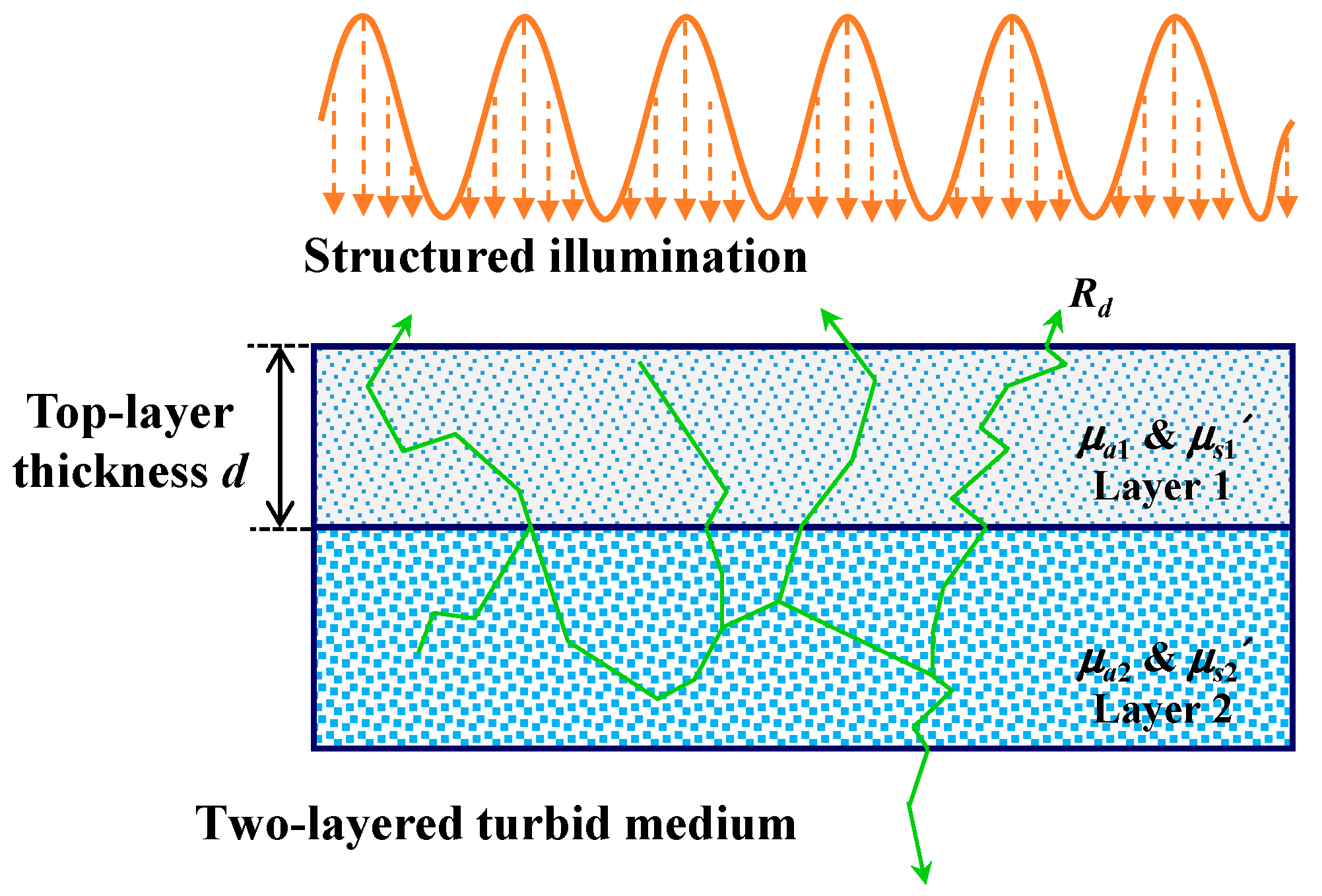
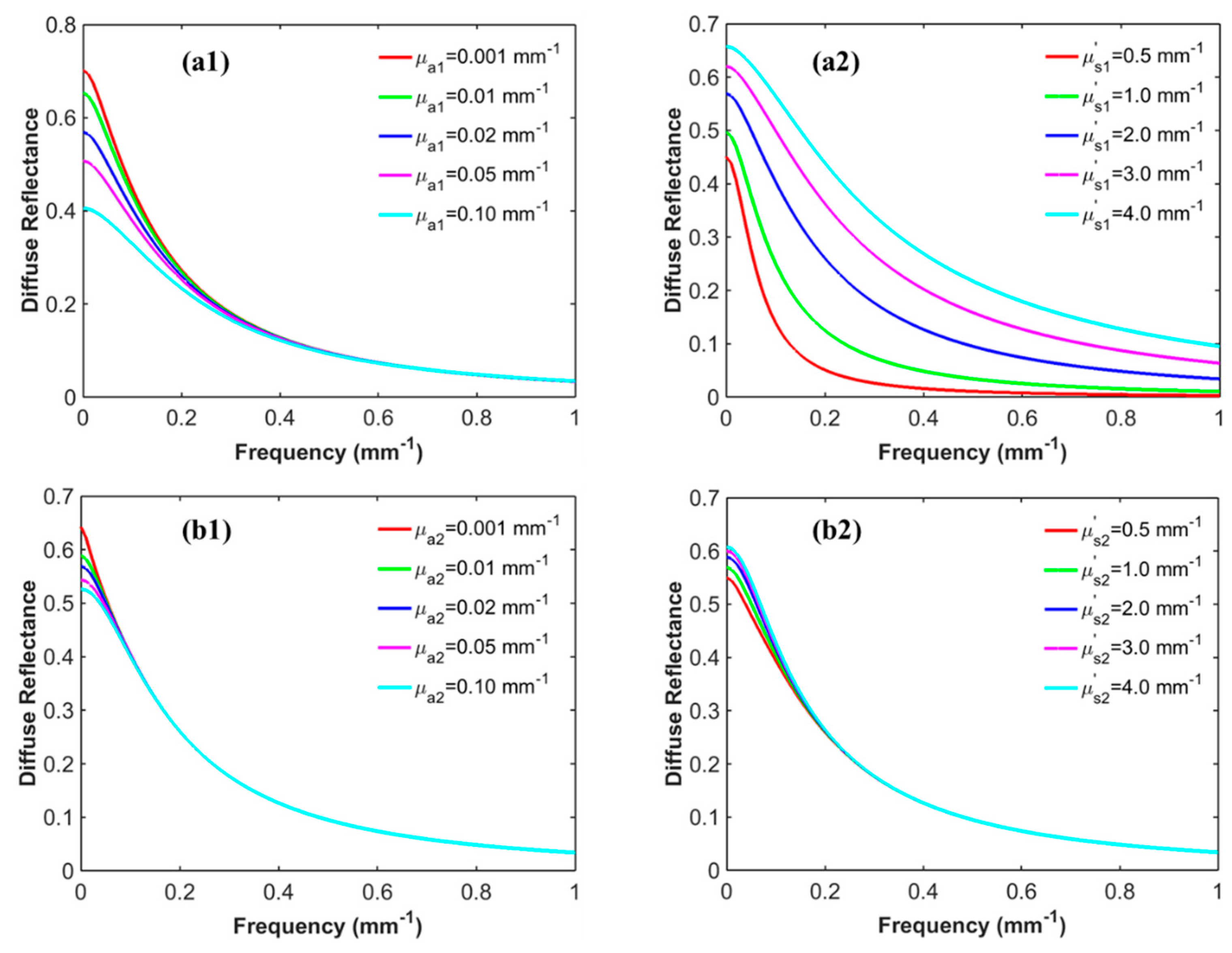
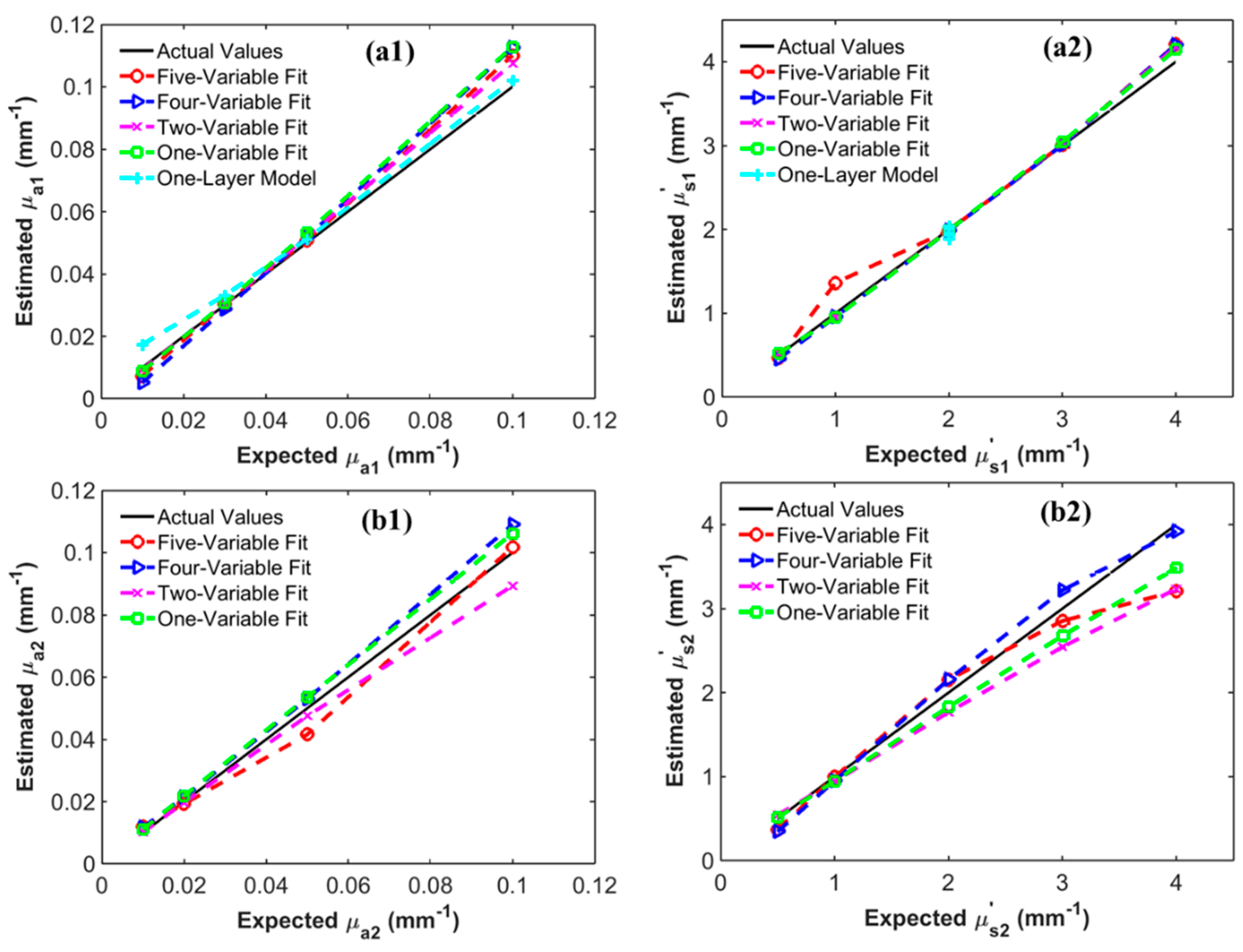
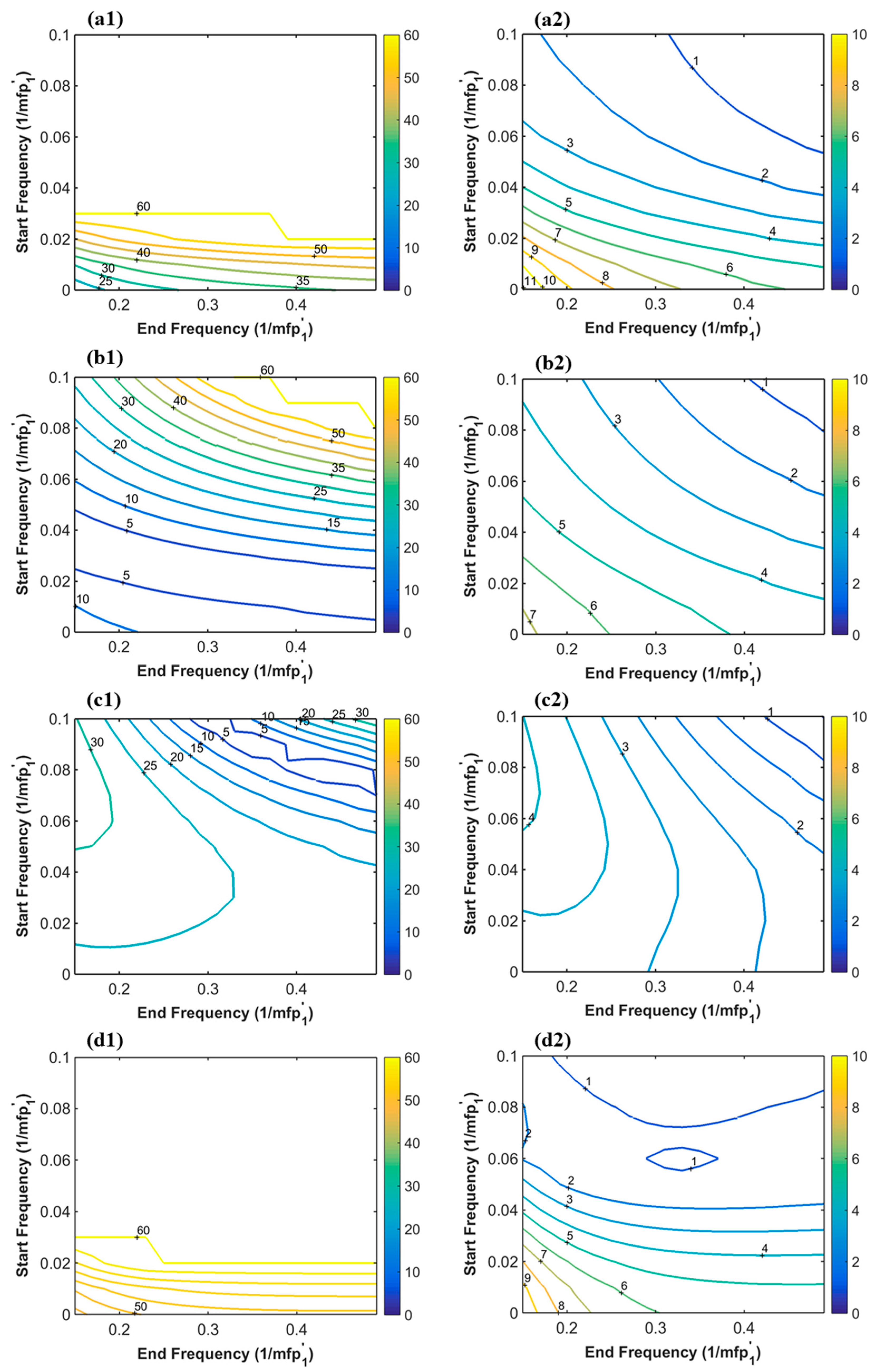
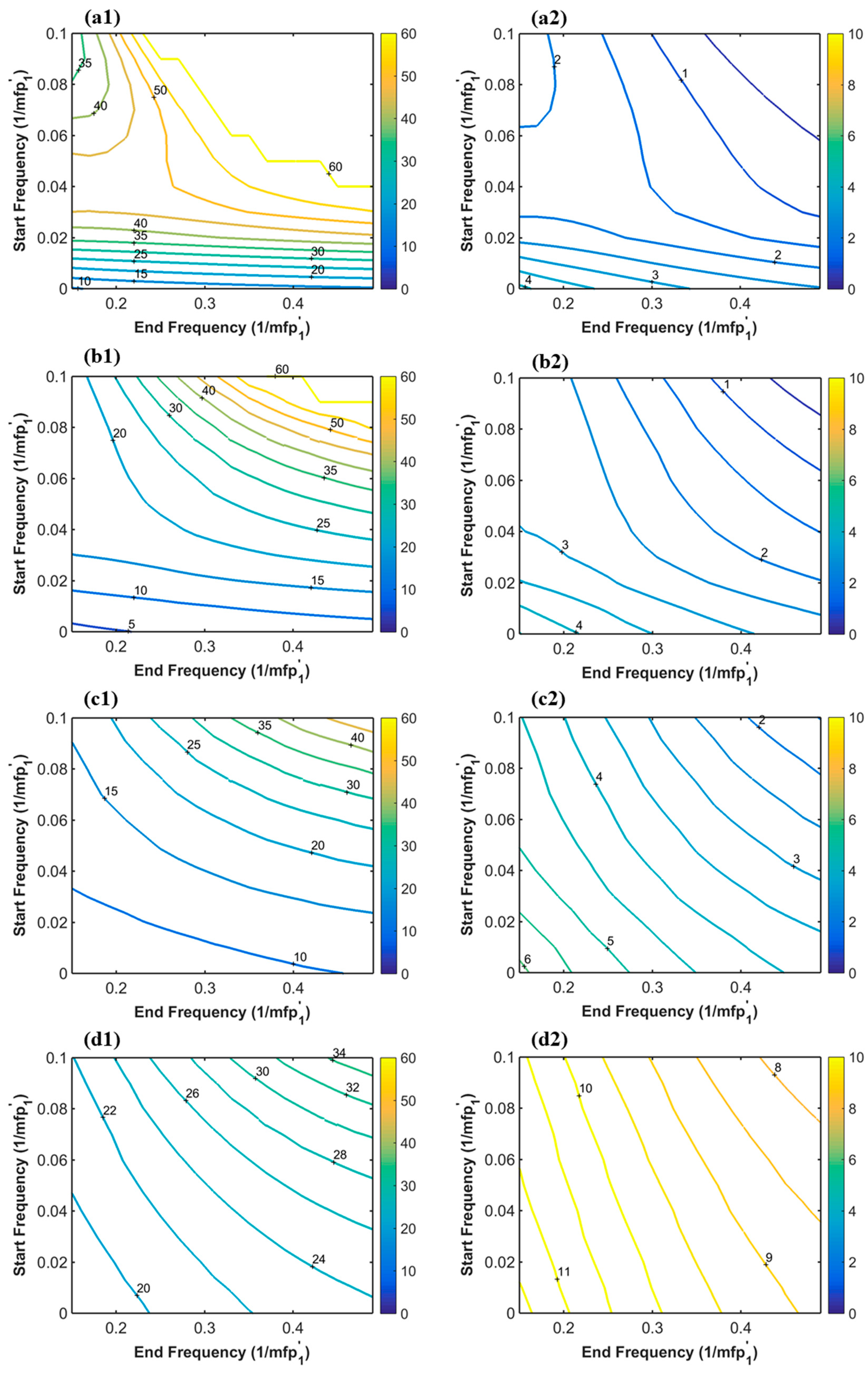
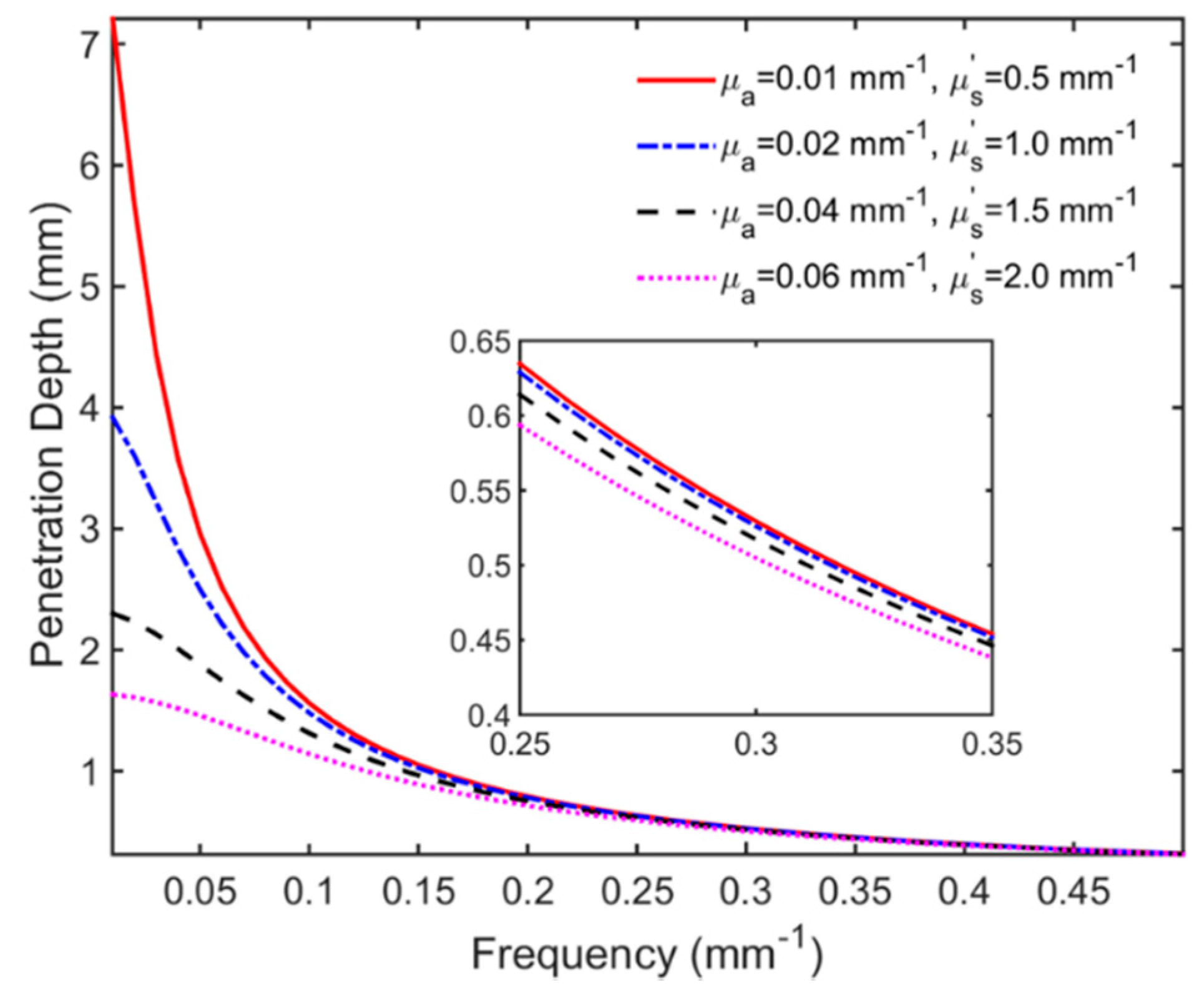
| Curve Fitting Method | Estimated Parameter | Known Parameter | Fitted Model |
|---|---|---|---|
| Five-variable fit | μa1, μs1′, μa2, μs2′, d | -- | Equation (2) |
| Four-variable fit | μa1, μs1′, μa2, μs2′ | d | Equation (2) |
| Two-variable fit | μa1, μs1′ or μa2, μs2′, | the other three | Equation (2) |
| One-variable fit | μa1 or μs1′ or μa2 or μs2′ | the other four | Equation (2) |
| One-layered model | μa1, μs1′ | -- | Equation (1) |
| Optical Property | Five-Variable Fit | Four-Variable Fit | Two-Variable Fit | One-Variable Fit | One-Layered Model |
|---|---|---|---|---|---|
| μa1 (%) | 9.84 | 17.25 | 4.78 | 8.14 | 12.23 |
| μs1′ (%) | 9.81 | 3.72 | 2.77 | 2.90 | 2.66 |
| μa2 (%) | 10.44 | 9.86 | 4.73 | 8.30 | -- |
| μs2′ (%) | 11.62 | 10.48 | 12.11 | 8.15 | -- |
Publisher’s Note: MDPI stays neutral with regard to jurisdictional claims in published maps and institutional affiliations. |
© 2021 by the authors. Licensee MDPI, Basel, Switzerland. This article is an open access article distributed under the terms and conditions of the Creative Commons Attribution (CC BY) license (http://creativecommons.org/licenses/by/4.0/).
Share and Cite
Hu, D.; Huang, Y.; Zhang, Q.; Yao, L.; Yang, Z.; Sun, T. Numerical Simulation on Spatial-Frequency Domain Imaging for Estimating Optical Absorption and Scattering Properties of Two-Layered Horticultural Products. Appl. Sci. 2021, 11, 617. https://doi.org/10.3390/app11020617
Hu D, Huang Y, Zhang Q, Yao L, Yang Z, Sun T. Numerical Simulation on Spatial-Frequency Domain Imaging for Estimating Optical Absorption and Scattering Properties of Two-Layered Horticultural Products. Applied Sciences. 2021; 11(2):617. https://doi.org/10.3390/app11020617
Chicago/Turabian StyleHu, Dong, Yuping Huang, Qiang Zhang, Lijian Yao, Zidong Yang, and Tong Sun. 2021. "Numerical Simulation on Spatial-Frequency Domain Imaging for Estimating Optical Absorption and Scattering Properties of Two-Layered Horticultural Products" Applied Sciences 11, no. 2: 617. https://doi.org/10.3390/app11020617
APA StyleHu, D., Huang, Y., Zhang, Q., Yao, L., Yang, Z., & Sun, T. (2021). Numerical Simulation on Spatial-Frequency Domain Imaging for Estimating Optical Absorption and Scattering Properties of Two-Layered Horticultural Products. Applied Sciences, 11(2), 617. https://doi.org/10.3390/app11020617









